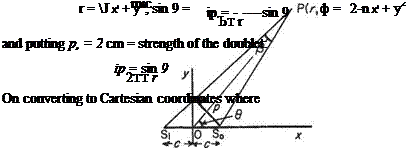Doublet
A doublet is a source and sink combination, as described above, but with the separation infinitely small. A doublet is considered to be at a point, and the definition of the strength of a doublet contains the measure of separation. The strength (ц) of a doublet is the product of the infinitely small distance of separation, and the strength of source and sink. The doublet axis is the line from the sink to the source in that sense.
Fig. 3.19
The streamlines due to a source and sink combination are circles each intersecting in the source and sink. As the source and sink approach, the points of intersection also approach until in the limit, when separated by an infinitesimal distance, the circles are all touching (intersecting) at one point – the doublet. This can be shown as follows. For the source and sink:
ip = (m/2n)l3 from Eqn (3.26)
By constructing the perpendicular of length p from the source to the line joining the sink and P it can be seen that as the source and sink approach (Fig. 3.19),
p —> 2c sin 9 and also p —> r(3
Therefore in the limit
|
V7*2+. |
![]()
 |
|
2c sin 9 = rp or /?
and rearranging gives
P+rtwy = 0
which, when ф is a constant, is the equation of a circle.
Therefore, lines of constant ip are circles of radius p/(4mp) and centres (0, p/(4irib)) (Fig. 3.20), i. e. circles, with centres lying on the Оу axis, passing through the origin as deduced above.
 |
Fig. 3.21
Consider again a source and sink set a very small distance, 2c, apart (Fig. 3.21). Then[8]











